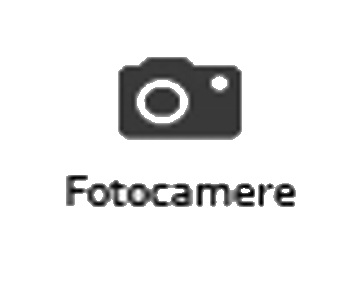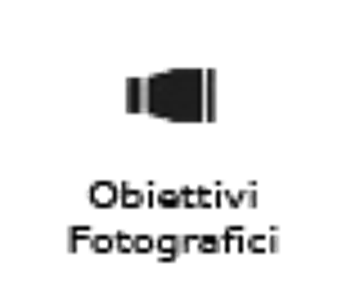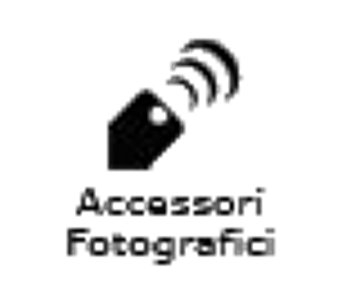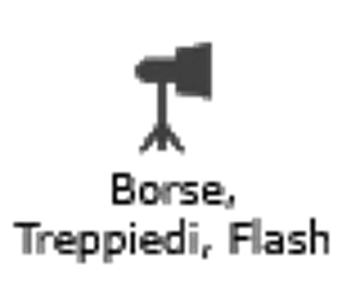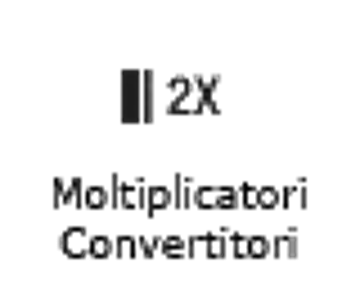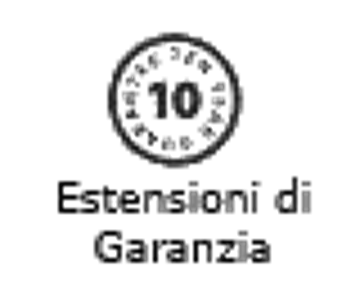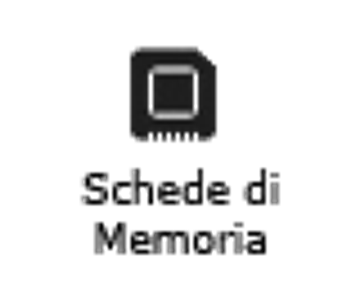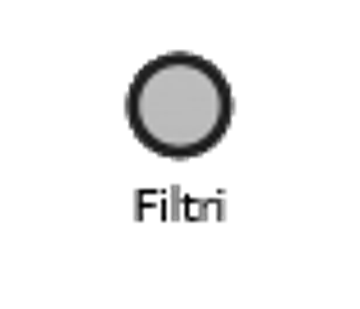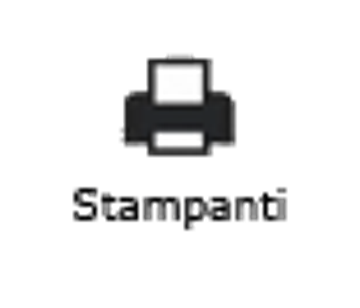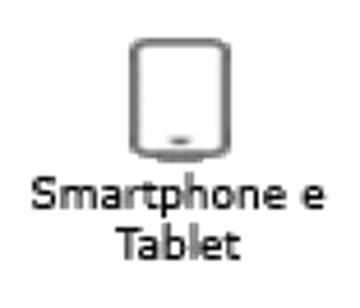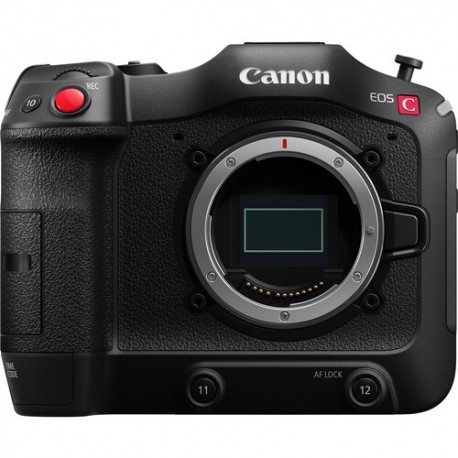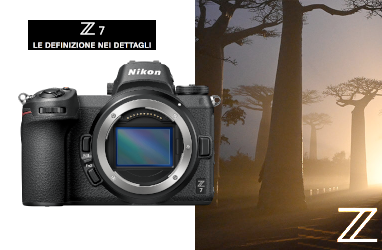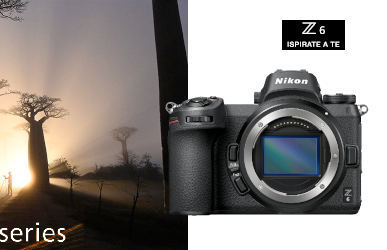CANON EOS C70 - Cinema Camera - Innesto RF - 2 Anni Di Garanzia In Italia
4507C002
Nuovo
Disponibile in 4/6 giorni
Video resolutions include DCI 4K capture at rates ranging from 23.98 to 60 fps, plus high-speed options up to 120 fps in UHD 4K and 180 fps in cropped 2K. Pro video functions include unlimited video recording, Dual Pixel CMOS AF autofocus control, a motorized ND filter wheel tucked into the shallower RF-mount flange depth, a BNC timecode input/output connector, and built-in dual mini-XLR audio inputs.
Exceptional Image Quality
For users seeking most of the benefits of a log workflow but with reduced turnaround times, choose the Canon Log 3 alternative with only a slightly reduced dynamic range of 14 stops.
- A built-in RF lens mount lends the EOS C70 compatibility with Canon's expanding line of high-performance RF-mount lenses.
- With a short flange distance, the RF mount helps to noticeably reduce the camera body's depth, resulting in a more compact design.
EF Lens Compatibility with Optional Adapter
To provide greater flexibility in lens choices, the EOS C70 camera is also compatible with the separately available EF-EOS R 0.71X EF to RF lens mount adapter. This adapter converts your full-frame lenses to Super35 format while also providing a handy aperture speed boost of around one stop The EF adapter passes EF lens data through the RF mount, providing full Dual-Pixel Autofocus and metadata information for select lenses. Additional compatible adapters include the EF-EOS R Canon Mount, Canon Control Ring Mount, Drop-In Circular Polarizer Filter Mount, and Drop-In Variable ND Filter Mount adapters.
Direct Touch Control
- Two mini-XLR inputs with phantom power and manual control dials provide professional audio recording options for the EOS C70
- The EOS C70 supports up to 4-channel audio using dual mini-XLR ports, an internal stereo mic, and a 3.5mm mic input
Built-In ND Filters
Designed specifically for the EOS C70's short flange distance, a thin motorized ND filter unit enables users to quickly select up to 10 stops of neutral density - an especially handy feature for ENG shooters or when shooting in quickly changing lighting conditions.
Timecode Input/Output
A BNC connector on the front of the EOS C70 enables users to input and output timecode, making synching on multicamera shoots easier.
Dual Pixel CMOS Autofocus with Touch AF and Face Detection
- Another innovative EOS C70 feature is the Dual Pixel CMOS AF Technology, which uses each pixel on the CMOS sensor for both focus detection and image information, resulting in precision focusing and optimal image quality. The EOS C70 is also the first Cinema EOS camera to feature the EOS iTR AF X autofocus function featuring a head-detection algorithm developed using deep-learning technology.
- In Face Detection mode, this algorithm helps to improve distance measuring and tracking reliability, even when a subject turns their head to the side or back.
- The EOS C70 also features the innovative Dual Pixel Focus Guide, which provides both front- and back-focus information to let users know where to set the focus during manual pulls.
- To smooth out handheld shots, the EOS C70 is the first Cinema EOS camera to offer enhanced image stabilization with coordinated control. When used with an RF-mount lens and the EOS C70's electronic IS, coordinated control optimizes hand-shake correction for even greater vibration reduction than that obtained with an EF-mount lens and electronic IS.
- When working in the 2K format, the EOS C70's Super16 Digital IS improves performance by using the peripheral area around the center of the 4K sensor to stabilize the image.
Fotocamera
Sensore immagine
Sensore
CMOS Super 35 mm
Sistema
Filtro a colori primari RGB (array Bayer)
Pixel totali per sensore
Circa 11,54 megapixel (4622 x 2496)
Pixel effettivi per sensore
4096 x 2160/2048 x1080: circa 8,85 MP
3840 x 2160/1920 x1080: circa 8,29 MP
Gamma dinamica
Canon Log 2/Canon Log 3: 1600% (ISO 800 o superiore)
Con Canon Log/Wide DR: 800% (ISO 400 o superiore)
Processore di immagine
Tipo
Triplo DIGIC DV 5
Obiettivo
Attacco obiettivo
Innesto EF Canon con Cinema Lock/innesto PL (compatibile con tecnologia Cooke/i)
in base alla versione
Obiettivo con innesto B4 tramite accessorio adattatore (EF orPL)
Fattore di ingrandimento dell'obiettivo (per obiettivi con innesto EF, fra cui quelli con focale fissa Cinema)
4096x2160 o 2048x1080: lunghezza focale x circa 1,460
3840x2160 o 1920x1080: lunghezza focale x circa 1,534
Adattatore B4 collegato: lunghezza focale x circa 1,3 (1,2947) (Full HD/1920x1080)
Versione con innesto PL: nessun fattore di ingrandimento per gli zoom Cinema di Canon
[Peripheral illumination correction/Correzione illuminazione periferica]
YES (dependent on lens used)
Filtro ND
Fino a 10 stop tramite il filtro ND integrato
Regolazione messa a fuoco
Innesto EF: tramite obiettivo, controllo wireless o telecomando cablato (in base all'obiettivo usato)
Innesto PL: solo obiettivi Cine Servo
Controllo diaframma
Tramite corpo, impugnatura, controllo wireless o telecomando remoto.
1/2 stop, 1/3 stop o controllo FINE.
Possibilità di mantenere un numero F costante durante l'uso dello zoom.
Supporto della tecnologia Cooke/I
SÌ (solo innesto PL)
Supporto obiettivi anamorfici
Sì
Sistema di stabilizzazione delle immagini
In base all'obiettivo usato
Registrazione
Opzioni di registrazione RAW
1. Capture Drive, CDX-36150: 4096x2160, 12 bit/10 bit, Canon Log 2 applicato
2. Capture Drive, CDX-36150: 4096x2160, 12 bit/10 bit, Canon Log 2 applicato
Registrazione interna
2 schede CFast 2.0™ per la registrazione XF-AVC o ProRes, scheda SD per la registrazione XF-AVC
Tempo di registrazione (scheda CFast 2.0™ da 64 GB)
XF-AVC - Intra: 810 Mbps, 10 min./160 Mbps, 50 min.
XF-AVC Long GOP 50 Mbps: 165 min.
ProRes: da confermare
Formati per la registrazione
Canon RAW .RMF, XF-AVC Intra, XF-AVC Long GOP. Proxy XF-AVC
ProRes, formato Apple Quick File 4444XQ/4444/422HQ/422
Velocità di elaborazione durante la registrazione
4K RAW: fino a 60P (fino a 120P per CDX-361501). Max 240 P (2K ritagliato)
Velocità di trasmissione durante la registrazione XF-AVC/Campionamento (modalità a 50 Hz) su scheda CFast 2.0™
50P: 4096x2160/3840x2160:
YCC422 10 bit, 810 Mbps intra-frame;
2048x1080/1920x1080:
RGB444 12 bit 440 Mbps intra-frame,
RGB444 10 bit 410 Mbps Intra-frame, YCC422 10 bit 310 Mbps Intra-frame,
50 Mbps Long GOP
50i: 1920x1080 YCC422 10 bit 50 Mbps Long GOP
25P: 4096x2160/3840x2160:
YCC422 10 bit, 410 Mbps intra-frame;
2048x1080/1920x1080:
RGB444 12 bit 225 Mbps intra-frame,
RGB444 10 bit 210 Mbps Intra-frame, YCC422 10 bit 160 Mbps Intra-frame
50 Mbps Long GOP
Velocità di trasmissione durante la registrazione ProRes/Campionamento (modalità a 50 Hz) su scheda CFast 2.0™
50,00P: 2048x1080/1920x1080/RGB444 12 bit YCC422 10 bit/ ProRes4444, ProRes 422HQ, ProRes422
25,00P: 4096x2160/3840x2160 YCC422 10 bit ProRes422HQ
2048x1080/1920x1080 RGB444 12 bit, ProRes4444/YCC422 10 bit, ProRes422HQ, ProRes422
24,00P: 4096x2160/3840x2160 YCC422 10 bit ProRes422HQ
2048x1080/1920x1080: RGB444 12 bit/ProRes4444:YCC422 10 bit ProRes422HQ, ProRes422
Velocità di trasmissione durante la registrazione XF-AVC/Campionamento (modalità a 50 Hz) su scheda SD
50P: 2048x1080/1920x1080: YCC420 8 bit/35 Mbps Long GOP
50i: 1920x1080: YCC420 8 bit/ 24 Mbps Long GOP
25P: 2048x1080/1920x1080: YCC420 8 bit/24 Mbps Long GOP
Slow/Fast Motion
Sì. 1 - 240 FPS in base all'impostazione
Registrazione intervallata
No
Registrazione fotogrammi
No
Pre-registrazione (registrazione cache)
No
Registrazione relay
Sì
Registrazione su doppio slot (contemporaneamente)
Sì
Scansione inversa
Sì
Conversione alta definizione->definizione standard
No
Supporti di archiviazione foto
Schede di memoria SD/SDHC
Dimensioni della registrazione con foto
Circa 930 KB a 2048x1080; Circa 880 KB a 1920x1080
Sistema
Monitor waveform
Sì. Tramite terminali MON.1/2, VIDEO o HDMI (non disponibile da SDI Out 1 -4)
Display a righe/Riga e punto/Selezione riga/Display di campo/RGBDisplay/YPrPb
Display falso colore (indicazione dell'esposizione)
Sì. Tramite terminali MON.1/2, VIDEO o HDMI (non disponibile da SDI Out 1 -4)
Barre colore
Sono disponibili le barre colore SMPTE, EBU e ARIB. Consulta il menu.
Peaking
Peaking 1, Peaking 2 (Colore, Guadagno, Frequenza personalizzabili)
Zebra
Livello 1; Livello 2; Entrambi
Uscita tramite HD-SDI o HDMI
Marcatori
On/Off (Rapporto di visualizzazione, Marcatore visualizzazione, Area sicura, Griglia, Orizzontale, Centrale)
EVF
EVF integrato
No
Accessorio EFV opzionale
Sì. Mirino elettronico OLED, EVF-V70
Pannello display
Display di controllo
A cristalli liquidi colorati da 3,0" (7,66 cm in diagonale), circa 1,036 milioni di punti
Ingressi/uscite
Ingresso audio
Connettore XLR a 3 pin x2 , mini-jack stereo da 3,5 mm (solo ingresso)
Uscita per cuffia
Mini-jack stereo da 3,5 mm (solo uscita)
Uscita per monitor video
MON.1/MON.2: jack BNC, solo uscita
HDMI
Connettore HDMI (tipo A) (solo uscita)
USB
No
Uscita SDI
Jack BNC (4 linee, solo uscita)
Time code
Jack BNC (ingresso/uscita)
Genlock
Jack BNC (solo uscita/funziona anche come connettore SYNC OUT)
Synch
Jack BNC (solo uscita/funziona anche come connettore GENLOCK)
Uscita component
No
Terminale AV
No
Uscita CC
Jack Fisher a 3 pin 24 V CC 2 A (solo uscita),
Jack LEMO a 2 pin 12 V CC 2 A (solo uscita)
Ingresso CC
Jack XLR a 4 pin
Ingresso controllo remoto
Mini-jack stereo da 2,5 mm per connettore TELECOMANDO A (solo ingresso)
Jack a 8 pin circolare per connettore TELECOMANDO B (per RS-422)
Terminale di controllo wireless
Sì, per WFT-E6B.WFT-E8
Terminale dell'obiettivo
Jack a 12 pin
Terminale Ethernet
Connettore Ethernet (RJ45) (supporta 1000 BASE-T)
Terminale CTRL
Specifiche proprietarie Canon, jack LEMO a 7 pin
Connettore video (per EVF)
Specifiche proprietarie Canon (jack speciale a 13 pin, solo uscita)
Varie
Indicatore di registrazione
Sì
Ghiera personalizzata
Sì
Funzioni di scatto
Livello di compensazione
Misurazione dell'esposizione
Esposizione manuale determinata dalle impostazioni relative a otturatore, iris, ISO/guadagno e filtro ND, Push Auto Iris, Auto Iris
Compensazione esposizione
Sì
Modalità Esposizione automatica
Auto Iris
Push Auto Iris
Sì, tutti gli obiettivi compatibili con i modelli EF, solo obiettivi Canon Cine Servo compatibili con le versioni PL
Blocco dell'esposizione
No
Impostazione AGC (Auto Gain Control)
Sì.
Sensibilità ISO
1 stop: [100], 160(*), 200, 400, 800, 1600, 3200, 6400, 12800, 25600, [51200,102400]
[---] Visualizzata quando l'espansione della velocità ISO è ON.
(*) Visualizzata quando l'espansione della velocità ISO è OFF.
1/3 di stop: [100, 125], 160, 200, 250, 320, 400, 500, 640, 800, 1000, 1250, 1600, 2000, 2500,
3200, 4000, 5000, 6400, 8000, 10000, 12800, 16000, 20000, 25600,
[32000, 40000, 51200, 64000, 80000, 102400]
[---] Quando l'espansione della velocità ISO è ON.
Sistema di messa a fuoco automatica (solo versione EF)
Dual Pixel CMOS AF, Contrast AF
Dimensioni riquadro AF (solo versione EF)
Grande; la dimensione equivale a circa il 20% (verticale) x 25% (orizzontale) della portata di visualizzazione immagine
Piccola; la dimensione equivale a circa il 20% (verticale) x 8% (orizzontale) della portata di visualizzazione immagine
Punto AF selezionabile in circa l'80% del sensore
Modalità di messa a fuoco automatica (solo versione EF)
One-Shot AF, Continuous AF e AF-Boosted MF sono le modalità disponibili. Tutte queste modalità possono essere attivate quando viene selezionata l'impostazione AF sul selettore AF/MF dell'obiettivo EF
[One-Shot AF/AF One-Shot]
[Continuous AF/AF continuo]
AF-Boosted MF
Face Detection AF (solo versione EF)
Face Priority o Face Only.
Guida alla messa a fuoco
Versione EF: tutti gli obiettivi Canon EF, obiettivi Canon Cine Servo compatibili
Versione PL: obiettivi Canon Cine Servo compatibili
Impostazione del guadagno
[-6 dB, -3 dB], -2 dB(*), 0 dB, 3 dB, 6 dB, 9 dB, 12 dB, 15 dB, 18 dB, 21 dB, 24 dB, 27 dB, 30 dB, 33 dB, 36 dB, 39 dB, 42 dB, [45 dB, 48 dB, 51 dB, 54 dB]
[---] Visualizzata quando l'espansione della velocità ISO è ON. (*) Visualizzata quando l'espansione della velocità ISO è OFF.
Quando l'espansione della velocità ISO è ON: da -2 dB a 54 dB
Quando l'espansione della velocità ISO è OFF: può essere impostato qualsiasi valore compreso fra -2 dB e 42 dB con incrementi di 0,5 dB.
Tempo
Modalità di controllo
Off; Velocità; Angolo; Scansione nitida (CS); Otturatore per scatti lenti (SLS)
Tempo
Da 1/1 a 1/2000 a seconda del frame rate e della modalità di controllo dell'otturatore, 39 impostazioni
Angolo otturatore
Da 11,25º a 360º a seconda del frame rate
Otturatore per scatti lenti (SLS)
1/3, 1/4, 1/6, 1/8, 1/12, 1/15, 1/25, 1/30 a seconda del frame rate
Scansione nitida
Da 24,00 Hz* a 250,40 Hz
(*) La frequenza varierà a seconda dell'impostazione del frame rate.
[Custom Picture/Immagine personalizzata]
Configurazioni salvate
Preimpostazione:
Canon Log 3: C.Gamut (Canon Log 3/Cinema Gamut/Neutra)
Canon Log 3: BT.2020 (Canon Log 3/BT.2020 Gamut/Neutra)
Canon Log 3: DCI-P3 (Canon Log 3/DCI-P3 Gamut/Neutra)
Canon Log 3: BT.709 (Canon Log 3/BT.709 Gamut/Neutra)
Canon Log 2: C.Gamut (Canon Log 2/Cinema Gamut/Neutra)
Canon Log 2: BT.2020 (Canon Log 2/BT.2020 Gamut/Neutra)
Canon Log 2: DCI-P3 (Canon Log 2/DCI-P3 Gamut/Neutra)
Canon Log 2: BT.709 (Canon Log 2/BT.709 Gamut/Neutra)
Canon Log (Canon Log/BT.709 Gamut/Cinema EOS Originale)
BT.2020 (Wide DR/BT.2020 Gamut/Neutra)
BT.709 (Wide DR/ BT.709 Gamut/Neutra)
Impostazioni principali: Canon Log 3,Canon Log 2, Canon Log, Wide DR, Normale 1(Standard),
Normale 2 (x4.0),Normale 3 (BT.709), Normale 4 (x5.0)
Spazio colore: BT.709 Gamut, BT.2020 Gamut, DCI-P3 Gamut,Cinema Gamut
Matrice colore: Neutra, Videocamera di produzione, Cinema EOS Originale, Video, Off
Supporto di archiviazione
Scheda di memoria SD/SDHC (tutti i dati di personalizzazione e i metadati), fino a 20 immagini personalizzate per scheda
Master Pedestal
Da -50 a +50
Master Black
Da -50 a +50 per ciascun canale, R, G, B
Gamma del nero
Livello, gamma e punto regolabili
Low Key Saturation
Da -50 a +50, regola la saturazione del colore in aree con scarsa luminosità
Knee
Regola gli elementi in sovraesposizione, avvio, inclinazione, saturazione
[Sharpness/Nitidezza]
Regolazione del livello, frequenza dettaglio H, coring, bilanciamento orizz./vert., limite, selezione, apertura knee e nitidezza in base al livello
Riduzione del rumore
Disattiva, Attiva (da 1 a 12)
Dettaglio pelle
Off, Basso, Medio, Alto/Tonalità, Croma, Area, Luminosità 32 intervalli
Riduzione selettiva del rumore
Off, Basso, Medio, Alto/Tonalità, Croma, Area, Luminosità
Matrice colore
Fase, guadagno e regolazione RGB, in coppia con selezione Gamma
Bilanciamento del bianco
Da -50 a +50 per i colori R e B
Correzione del colore
Selezione area/analisi area di due aree
Livello di impostazione
Da -50 a +50 On/Off
Clip 100% IRE
Limita uscita a 100% dopo regolazione dell'impostazione del livello
Specifiche Wi-Fi e GPS
Informazioni GPS (accessorio opzionale)
Latitudine/longitudine/altezza, orario universale (UTC)
Bilanciamento del bianco
Auto/Automatico
Sì
Preimpostazione
Luce giorno (5400K), Tungsteno (3200K), Kelvin (2000K-15000K, intervalli 100K), Set A, Set B
Attivazione bilanciamento del bianco
SÌ. Da -9 a +9 (solo Luce giorno e Tungsteno)
Bilanciamento del nero
Regolazione del bilanciamento del nero
Sì
Time code
Sistema Countup
Regen, RecRun, FreeRun, External, Hold (drop frame disponibile per alcune velocità di elaborazione dei fotogrammi)
Impostazione valore iniziale
“00:00:00:00”, Set, Reset selezionabile
Audio
Registrazione
Registrazione interna e Capture Drive: PCM lineare 48 KHz, 24 bit, 4 canali
RAW (SDI OUT): PCM lineare 48 KHz, 16 bit, 2 canali
Ingresso digitale disponibile in base agli standard AES3 sugli ingressi analogici a due canali (XLR), (48 kHz/24 bit/2 canali).
Accessori
Forniti in dotazione
Unità porta microfono, base di aggancio, impugnatura, attacchi per prolunga, gambe della base x4
Brugola (1/4"), brugola (M4), base di rinforzo, ganci di misurazione x2, batteria al litio (CR2025)
Opzionale
(inclusi quelli di cui è al momento vietata la vendita)
Telecomando Canon RC-V100, trasmettitore wireless Canon WFT-E6 / WFT-E8, ricevitore GPS Canon GP-E1, cavo unità Canon UN-5/UN-10, cavo telecomando a 8 pin Canon RR-10 / RR-100
Adattatore Canon B4 MO-4E / MO-4P, mirino elettronico OLED Canon Electronic View Finder EVF-V70, unità di comando a distanza Canon OU-700, unità di supporto a spalla Canon SU-15, impugnatura a spalla Canon SG-1, cavo per unità di comando a distanza UC-V75/UC-V1000
Accessori di terze parti
Codex CDX-36150 (registratore Codex per D174)
Batteria con innesto a V IDX
Varie
Intervallo temperatura di funzionamento
Circa Da 0°C a 40°C, 85% (umidità relativa)
Circa Da -5°C a +45°C, 60% (umidità relativa)
- Canon EOS C70 Cinema Camera (RF Mount)
- Canon CA-CP200L Compact AC Power Adapter
- CG-A20 Battery Charger
- AC Power Cable
- Canon BP-A30 Battery Pack for EOS C300 Mark II, C200, and C200B
- Handle Unit
- Microphone Holder
- Body Cap
- SS-1200 Shoulder Strap
- Tape Measure Hook
- Shoe Mount Bracket

